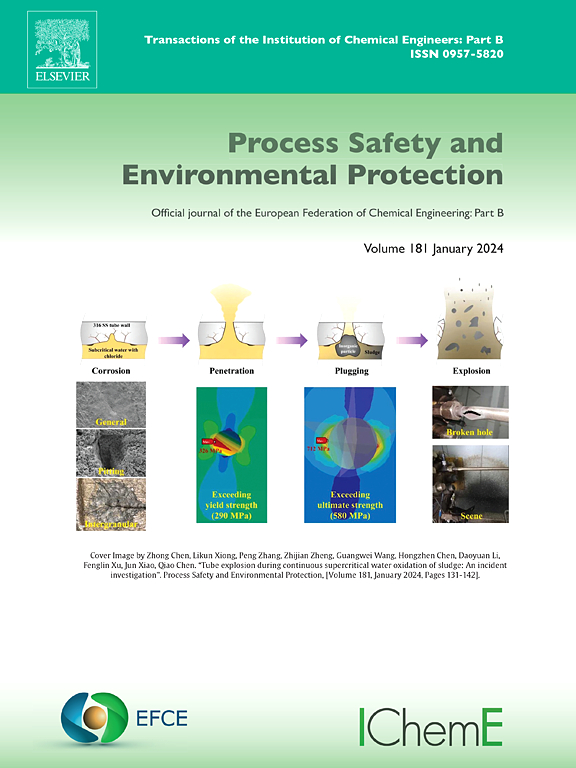Aluminum smelting residue upcycling via targeted fluoride extraction and alkaline-driven cryolite synthesis
IF 6.9
2区 环境科学与生态学
Q1 ENGINEERING, CHEMICAL
引用次数: 0
Abstract
Spent carbon anode, a byproduct of the aluminum electrolytic process, are characterized by a significant concentration of fluorides. It is crucial to manage their disposal with the highest level of care, as improper handling may lead to adverse environmental consequences. Chemical leaching is widely utilized in solid waste disposal due to its efficiency and scalability; however, it presents challenges such as process complexity and the necessity for secondary recovery of substantial filtrate volumes. This study introduces an optimized chemical leaching and recovery process aimed at efficient fluoride extraction. The alkaline leaching recovery method was systematically re-evaluated based on the various types and forms of fluorides present in spent carbon anode. Cryolite-type fluorides exhibit enhanced reactivity and separability within an alkaline environment. Under optimal conditions with a leaching duration of 30定向提氟和碱驱动冰晶石合成铝冶炼渣资源化研究
废碳阳极是铝电解过程的副产品,其特点是氟化物浓度很高。至关重要的是要以最高水平的护理管理它们的处置,因为不当处理可能导致不利的环境后果。化学浸出因其高效和可扩展性在固体废物处理中得到广泛应用;然而,它提出了一些挑战,如工艺复杂性和需要对大量滤液进行二次回收。介绍了一种优化的化学浸出回收工艺,旨在有效地提取氟化物。根据废碳阳极中氟化物的不同类型和形态,对碱浸回收方法进行了系统的评价。冰晶石型氟化物在碱性环境中表现出增强的反应性和可分离性。在最佳浸出条件下,浸出时间为30min,氟浸出率可达95.50%。测定浸出渣中残留的氟化钙和氧化铝为不溶物。采用单步碱性浸出法对废碳阳极进行环境友好处理是可行的。F -, Al3+和Na+在碱性环境中的恢复机制是直接的。在低F/Al摩尔比的溶液中,析出物主要由氢氧化铝和冰晶石组成;相反,随着F/Al比值的增加,冰晶石成为主要析出物。在优化的工艺条件下,氟回收率超过97%。综上所述,从废碳阳极中提取氟化物和合成冰晶石的碱性浸出策略在简单、高效和可扩展性方面具有显著优势,为工业处理实践提供了新的见解。
本文章由计算机程序翻译,如有差异,请以英文原文为准。
求助全文
约1分钟内获得全文
求助全文
来源期刊

Process Safety and Environmental Protection
环境科学-工程:化工
CiteScore
11.40
自引率
15.40%
发文量
929
审稿时长
8.0 months
期刊介绍:
The Process Safety and Environmental Protection (PSEP) journal is a leading international publication that focuses on the publication of high-quality, original research papers in the field of engineering, specifically those related to the safety of industrial processes and environmental protection. The journal encourages submissions that present new developments in safety and environmental aspects, particularly those that show how research findings can be applied in process engineering design and practice.
PSEP is particularly interested in research that brings fresh perspectives to established engineering principles, identifies unsolved problems, or suggests directions for future research. The journal also values contributions that push the boundaries of traditional engineering and welcomes multidisciplinary papers.
PSEP's articles are abstracted and indexed by a range of databases and services, which helps to ensure that the journal's research is accessible and recognized in the academic and professional communities. These databases include ANTE, Chemical Abstracts, Chemical Hazards in Industry, Current Contents, Elsevier Engineering Information database, Pascal Francis, Web of Science, Scopus, Engineering Information Database EnCompass LIT (Elsevier), and INSPEC. This wide coverage facilitates the dissemination of the journal's content to a global audience interested in process safety and environmental engineering.
 求助内容:
求助内容: 应助结果提醒方式:
应助结果提醒方式:


